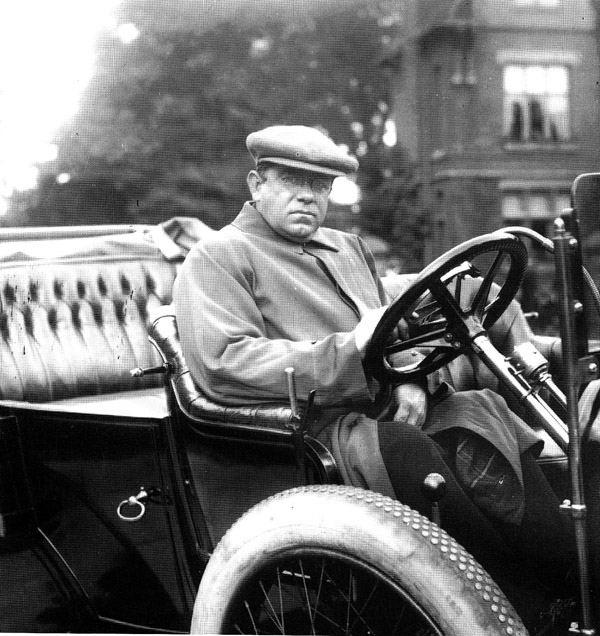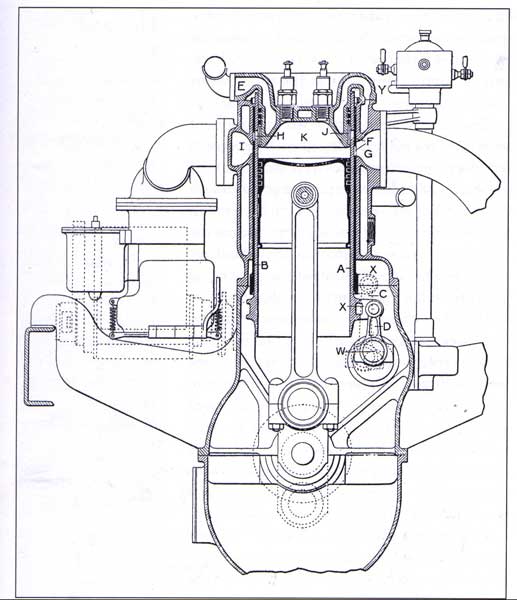| |
Silent Knight
By the end of the decade, production of the poppet valve engine had been surpassed by that of the sleeve valve engine. Dr. Lanchester had joined Daimler some years earlier as a consultant and had developed the flywheel on the crankshaft, which reduced vibration. 1910 saw David Lloyd George's people's budget increase car taxation 8 fold on the larger engined cars over 60HP, giving an equivalent road tax in today's terms of over £2000. Subsequently, Daimler ceased production of the larger engined cars, but sales were badly affected on all models. Also in 1910, an amalgamation was proposed between the Birmingham Small Arms factory and Daimler, and was accepted by the board. In the same year BSA produced their first motorcycle. |
 |
 |
| Charles Yale Knight born in Salem Indiana in 1868 was a journalist and a printer working for the Minneapolis Tribune. He then moved to Chicago and founded the magazine Dairy Produce in 1894. In 1901 he bought the 15th 'Waterless Knox' but found the air cooled engine very noisy. A couple of years later he bought a 'Searchmont' auto very cheaply, after the collapse of the company, but found it prone to valve spring breakages. These two events led Knight to start a quest for a silent engine without the problem of poppet valve and their associated problems. Recalling his youth he remembered repairing the slide valve mechanism on his father's steam driven saw mill. Financed by a Chicago merchant named Lyman Bernard Kilbourne, he began experiments with slide valve engines. By 1904 he had devised an engine in which the piston was surrounded by double concentric sleeves, whose rise and fall was controlled by a subsidiary crankshaft. Slots cut in the walls of these sleeves coincided with the inlet and exhaust ports in the cylinder walls. The top of the cylinder walls and the top of the cylinder was sealed by a separate cylinder head, which without the need to accommodate poppet valves could have an uninterrupted hemispherical combustion chamber, with the spark plug at its apex- a near ideal configuration. Since all moving parts slid on a film of lubricant and there were no impact members, as in a conventional engine, this resulted in great mechanical silence. Knight's double sleeve valve engine was finished in October 1904, it was a 2523cc four cylinder unit which was installed in a Panhard type car - actually his 'Searchmont' At the time the American car industry was selling all the cars they could manufacture and so Knight could not interest them in taking up the rights to his engine, as this would involve them in the cost of introducing a new engine. Although 38 cars were built during 1907 using chassis supplied by Garford ( also responsible for the first - petrol driven Studebakers) there were comments from the general public who when they saw them said, 'they rolled along the streets quiet and smooth like rubber balls'. Mr Manville chairman of the Daimler board heard about the 'Silent Knight' and was very interested, at the time they were feeling very threatened by Napier who had high kudos in the Daimler luxury market, so it was that Daimler developed the Silent Knight. They used this engine in their vehicles for many years, production finally ceased due to the engines' heavier weight and habit of producing a trail of smoke! Of course the further development of the poppet valve engine which had become more reliable and quieter aided its demise. |
Top
|
|

